M-77 Oganj
The M-77 Oganj is a 128mm self-propelled multiple rocket launcher developed in the former Yugoslavia. NATO designation is the YMRL-32
| M-77 Oganj | |
|---|---|
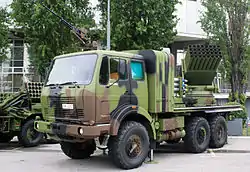 M-77 Oganj of the Serbian Army | |
| Type | Self-propelled multiple rocket launcher |
| Place of origin | Yugoslavia |
| Service history | |
| In service | 1977–present |
| Wars | Yugoslav Wars |
| Production history | |
| Designer | Military Technical Institute Belgrade |
| Designed | 1968-1975 |
| Manufacturer | Bratstvo Novi Travnik Bosnia and Herzegovina, Krusik Valjevo Serbia , IMK 14. oktobar Kruševac Serbia |
| Produced | 1975 |
| Specifications | |
| Mass | 22.4 tonnes (49,383 lbs) |
| Length | 8.4 m (27 ft 7 in) |
| Width | 2.49 m (8 ft 2 in) |
| Height | 3.1 m (10 ft 2 in) |
| Crew | 5 |
| Cartridge | Length: 2.6 m (8 ft 6 in) Weight: 65 kg (143 lb) Warhead: 20 kg (44 lb) |
| Caliber | 128 mm (5.0 in) |
| Barrels | 32 |
| Maximum firing range | 20 km (12 mi) |
Secondary armament | NSV or M2 Browning machine gun |
| Maximum speed | 80 km/h (50 mph) |
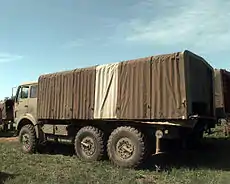
Development
Development started in 1968. Prof. Obrad Vucurević, Mechanical Engineer at the time, and Chief operating officer of the Artillery department of Military Technical Institute Belgrade, developed and managed construction and production of the M-77 Oganj.[1]
The 6 pre-serial production version, based on a FAP 2220 6x6 truck, was shown to the public for the first time in 1975. Serial production started two years later. The M-77 is mounted on FAP 2026 BDS/A 6x6 truck bed. The rocket system is placed on the back of the platform with 32 128mm launch tubes capable of reaching targets 20,600 metres away. The crew consists of five men.[2] In 1994 Serbia developed new version called Oganj C with designation M94. Oganj C(M94) could fire two type of rockets M91 (cluster-type warhead with 40 submunition grenades) and M77 (HE warhead). Other feature was design that it is caring reload rocket pack of 32 additional rockets that allows the launcher to be reloaded within 3 minutes for second salvo.
Unique features
One of unique features of Oganj M-77 is the movable canvas that allows the vehicle to be easy masked, and become very hard to be spotted by the enemy until it is in combat position and ready to fire. In that way it can be used to mislead enemy and is an effective way of Military deception. Originally invented in 1977 by Military Technical Institute Belgrade, the system saw later use in China in the Type 90A Type 90B and PR50 MLRS.
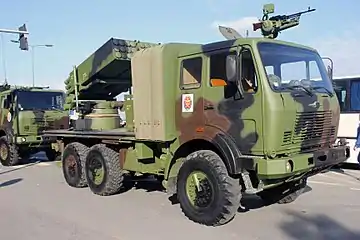
Modernization
Military Technical Institute Belgrade on demand from Serbia army has produced modernization program for Oganj M-77. Fixed barrels will be replaced with container system similar like LRSVM Morava and it will include modern navigation and fire control system. Containers will allow Oganj to use many different rockets including 107mm, Plamen 128mm, Grad 122mm and Oganj 128mm. As part of modernization new rocket 128mm with range of 50 km and better CEP will be produced by Krušik Valjevo.
There is currently one versions of modernized M-77 launcher in serial production. It is based on standard chassis with canvas made of exiting M-77 Oganj launchers that has new modern digital Fire-control system and possibilities to use containers.
Further development of M-77 concept and LRSVM Morava has given new modular launcher Oganj LRSVM M18 - with armored cabin on 6x6 chassis for close battlefront action and possibilities to launch Košava 1 and ALAS (missile) among other missiles[3][4]
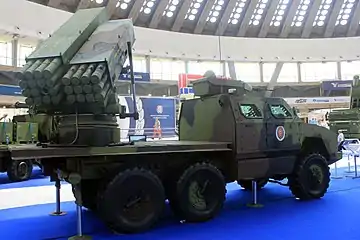
Operators
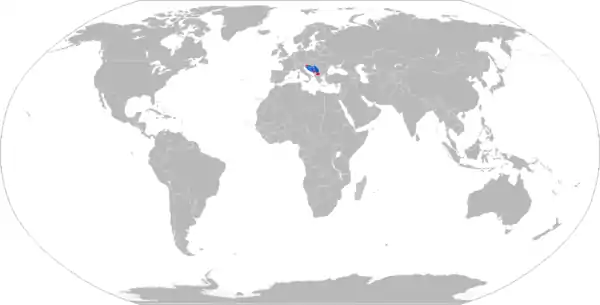
Current operators
 Bosnia and Herzegovina - 20[5]
Bosnia and Herzegovina - 20[5] Croatia - 12 (phased out, to be reactivated in 2015, uses 122 mm rockets)
Croatia - 12 (phased out, to be reactivated in 2015, uses 122 mm rockets) Serbia - 60[6]
Serbia - 60[6]
Former operators
.svg.png.webp) Yugoslavia - passed on to successor states
Yugoslavia - passed on to successor states
See also
Related development
Comparable systems
Compatible with
- LRSVM Morava New developed MLRS for Serbia Army and export intended to replace or complement Oganj M-77, Plamen M-63 and Grad BM-21
References
- Obrad Vucurović Archived March 2, 2009, at the Wayback Machine
- M-77 at FAS.org
- https://www.rtv.rs/sr_lat/drustvo/vulin-vojska-srbije-ne-prestaje-sa-modernizacijom-i-opremanjem_1118242.html
- http://www.mod.gov.rs/lat/15942/ministar-vulin-unapredjujemo-borbenu-gotovost-15942
- Administrator. "Bosnia Herzegovina army land ground armed defense forces military equipment armored vehicle UK | Bosnia Herzegovina army land ground forces UK | East Europe UK". www.armyrecognition.com. Retrieved 2018-04-01.
- Military Balance 2016. International Institute for Strategic Studies. Arundel House, Temple Place, London, UK. 9 February 2016. ISBN 978-1-85743-835-2. OCLC 920018706.CS1 maint: others (link)
| Wikimedia Commons has media related to M-77 Oganj. |
